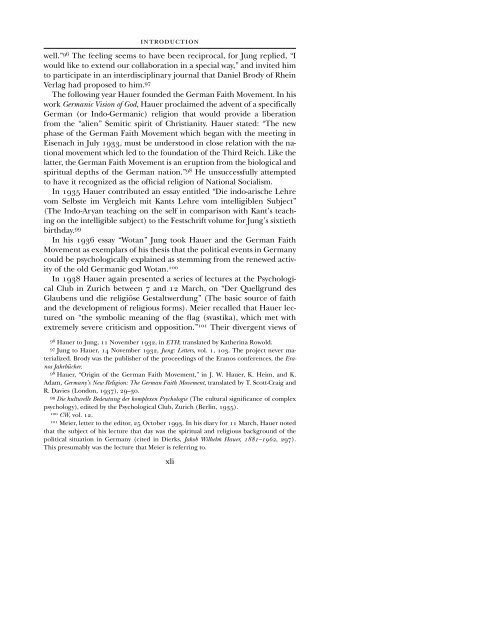CG JUNG - Countryside Anarchist
CG JUNG - Countryside Anarchist
CG JUNG - Countryside Anarchist
Create successful ePaper yourself
Turn your PDF publications into a flip-book with our unique Google optimized e-Paper software.
INTRODUCTION<br />
well.” 96 The feeling seems to have been reciprocal, for Jung replied, “I<br />
would like to extend our collaboration in a special way,” and invited him<br />
to participate in an interdisciplinary journal that Daniel Brody of Rhein<br />
Verlag had proposed to him. 97<br />
The following year Hauer founded the German Faith Movement. In his<br />
work Germanic Vision of God, Hauer proclaimed the advent of a specifically<br />
German (or Indo-Germanic) religion that would provide a liberation<br />
from the “alien” Semitic spirit of Christianity. Hauer stated: “The new<br />
phase of the German Faith Movement which began with the meeting in<br />
Eisenach in July 1933, must be understood in close relation with the national<br />
movement which led to the foundation of the Third Reich. Like the<br />
latter, the German Faith Movement is an eruption from the biological and<br />
spiritual depths of the German nation.” 98 He unsuccessfully attempted<br />
to have it recognized as the official religion of National Socialism.<br />
In 1935 Hauer contributed an essay entitled “Die indo-arische Lehre<br />
vom Selbste im Vergleich mit Kants Lehre vom intelligiblen Subject”<br />
(The Indo-Aryan teaching on the self in comparison with Kant’s teaching<br />
on the intelligible subject) to the Festschrift volume for Jung’s sixtieth<br />
birthday. 99<br />
In his 1936 essay “Wotan” Jung took Hauer and the German Faith<br />
Movement as exemplars of his thesis that the political events in Germany<br />
could be psychologically explained as stemming from the renewed activity<br />
of the old Germanic god Wotan. 100<br />
In 1938 Hauer again presented a series of lectures at the Psychological<br />
Club in Zurich between 7 and 12 March, on “Der Quellgrund des<br />
Glaubens und die religiöse Gestaltwerdung” (The basic source of faith<br />
and the development of religious forms). Meier recalled that Hauer lectured<br />
on “the symbolic meaning of the flag (svastika), which met with<br />
extremely severe criticism and opposition.” 101 Their divergent views of<br />
96 Hauer to Jung, 11 November 1932, inETH; translated by Katherina Rowold.<br />
97 Jung to Hauer, 14 November 1932, Jung: Letters, vol. 1, 103. The project never materialized.<br />
Brody was the publisher of the proceedings of the Eranos conferences, the Eranos<br />
Jahrbücher.<br />
98 Hauer, “Origin of the German Faith Movement,” in J. W. Hauer, K. Heim, and K.<br />
Adam, Germany’s New Religion: The German Faith Movement, translated by T. Scott-Craig and<br />
R. Davies (London, 1937), 29–30.<br />
99 Die kulturelle Bedeutung der komplexen Psychologie (The cultural significance of complex<br />
psychology), edited by the Psychological Club, Zurich (Berlin, 1935).<br />
100 CW, vol. 12.<br />
101 Meier, letter to the editor, 25 October 1993. In his diary for 11 March, Hauer noted<br />
that the subject of his lecture that day was the spiritual and religious background of the<br />
political situation in Germany (cited in Dierks, Jakob Wilhelm Hauer, 1881–1962, 297).<br />
This presumably was the lecture that Meier is referring to.<br />
xli


